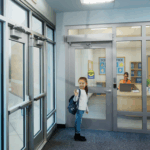This article will be published in the June 2020 issue of Door Security + Safety
.

 The International Energy Conservation Code (IECC) is the model energy code used in the United States. State adoptions of an energy code are crucial because buildings consume about 40% of the energy used in the U.S. The IECC sets minimum standards for new construction that address the building’s walls, floors, ceilings, lighting, windows, doors, and air leakage. According to the US Department of Energy’s State Code Adoption Tracking Analysis, almost all states have adopted the IECC and/or ANSI/ASHRAE/IES Standard 90.1-2019 – Energy Standard for Buildings Except Low-Rise Residential Buildings.
The International Energy Conservation Code (IECC) is the model energy code used in the United States. State adoptions of an energy code are crucial because buildings consume about 40% of the energy used in the U.S. The IECC sets minimum standards for new construction that address the building’s walls, floors, ceilings, lighting, windows, doors, and air leakage. According to the US Department of Energy’s State Code Adoption Tracking Analysis, almost all states have adopted the IECC and/or ANSI/ASHRAE/IES Standard 90.1-2019 – Energy Standard for Buildings Except Low-Rise Residential Buildings.
In the International Building Code (IBC), the IECC is referenced in Chapter 13 – Energy Efficiency. This chapter requires all buildings and structures to be designed and constructed in accordance with the IECC and governs the design and construction of buildings for energy efficiency. Unless a state modification removes the requirements of Chapter 13, adoption of the IBC would mandate compliance with the IECC, as this is the only way to demonstrate that a building complies with Chapter 13 of the IBC. For both residential and commercial buildings, the IECC addresses the design of energy-efficient building envelopes, as well as energy-efficient utilities such as electrical distribution and illumination, water heating, and mechanical systems.
Based on the IECC, most building entrances require vestibules, to reduce the loss of conditioned air – whether heated or cooled – when the exterior door is opened. All doors opening into and out of the vestibule are required to have self-closing devices, as doors standing open would defeat the purpose of the vestibule.
The IECC does not specify the size of the vestibule – the code only requires the vestibule to be large enough that it is not necessary for the interior and exterior doors to be open at the same time while a building occupant travels through. However, the required size of the vestibule is addressed by ICC A117.1 – Accessible and Usable Buildings and Facilities. The requirements of this standard are consistent with those of the ADA Standards for Accessible Design.
ICC A117.1 ensures that there is adequate maneuvering space for a person using a wheelchair to move through the vestibule and operate the doors. The standard requires a minimum distance between doors or gates in a series of at least 48 inches plus the width of any door or gate swinging into a space, and the space between the doors or gates must provide a turning space. For most vestibule configurations – where both doors swing in the direction of egress – the minimum vestibule size is approximately 5 feet wide and 7 feet long (this can vary depending on the door width and other factors).
There are seven locations where the IECC does NOT require a vestibule:
- Buildings in Climate Zones 1 and 2: Chapter 3 of the IECC includes a map of the U.S. climate zones. Climate Zone 1 includes the southern tip of Florida as well as Hawaii, Guam, Puerto Rico, and the Virgin Islands. Climate Zone 2 includes a portion of California, Arizona, Texas, Louisiana, Mississippi, Alabama, Georgia, and Florida. Buildings in the portions of these states which are classified as either Climate Zone 1 or 2 are not required to have vestibules.
- Doors that are not intended for use by the public: This would include doors to mechanical or electrical equipment rooms, or doors that are intended to be used only by employees. The IBC does not establish a limit on the area of these rooms or spaces.
- Doors which open to the exterior directly from a sleeping unit or dwelling unit: Doors leading from the exterior directly to an individual apartment, condominium, or motel room are not required to have vestibules. If the dwelling units or sleeping units are accessed from an interior corridor, the building entrances leading to the corridors and common areas would require vestibules in compliance with the IECC.
- Doors that open directly to the exterior from a space less than 3,000 square feet (298 m2) in area: Although the air temperature in small rooms is affected when doors open directly to the exterior, the overall impact of this energy loss is low in the context of the entire building.
- Revolving doors: A common question is whether vestibules are still required if an entrance includes a revolving door, because the revolving door provides a buffer between the interior and exterior air. The IECC specifically states that the installation of a revolving door, or several revolving doors, does not eliminate the requirement for a vestibule serving the adjacent swinging doors. The exception for revolving doors is meant to indicate that a vestibule with two sets of revolving doors – one exterior, one interior – would not be required.
- Doors used primarily for movement of vehicles or material handling, and adjacent personnel doors: For example, doors located in the loading dock area of a warehouse or manufacturing facility are not required to have vestibules, because the garage/dock areas are not typically heated or cooled at the same level found in other interior spaces.
- Doors that have an air curtain meeting the requirements of the IECC: The IECC sets minimum standards for the air curtain, including the velocity (not less than 6.56 feet per second (2 m/s) at the floor). The air curtain must be tested in accordance with ANSI/AMCA 220 – Laboratory Methods of Testing Air Curtains for Aerodynamic Performance Rating and installed per the manufacturer’s instructions. When the door is opened, the air curtain will operate to help prevent energy loss and saves space when it is used in lieu of a vestibule. Air curtains are also allowed as an alternative to vestibules by the 2019 edition of ASHRAE Standard 90.1.
When designing vestibules and specifying, scheduling, or installing doors and hardware for building entrances, it’s important to be familiar with the requirements of the IECC, or the adopted energy code in the project’s jurisdiction. A future Decoded article will address other energy code requirements related to doors, such as thermal transmission through the doors themselves. For more information about energy efficiency requirements in your project’s jurisdiction, refer to the adopted energy code.
You need to login or register to bookmark/favorite this content.





A common retail door vestibule (for larger stores) is a pair of automatic entries. Even if space more than 7′ apart, it is common for the inner door to open as a person passes through the outer one, due to the automatic sensors being set to make it easy for someone to come in / not wait for the second door to open; or, to be close enough to the inside sensor for the outer door, to keep it still open. Any comments on this?
For additional information on applicability, refer to 2015/2018 IECC Section C402.5.7 Vestibules. Your comment is crucial (and appreciated) that accessibility regulations will directly impact vestibule dimensions.